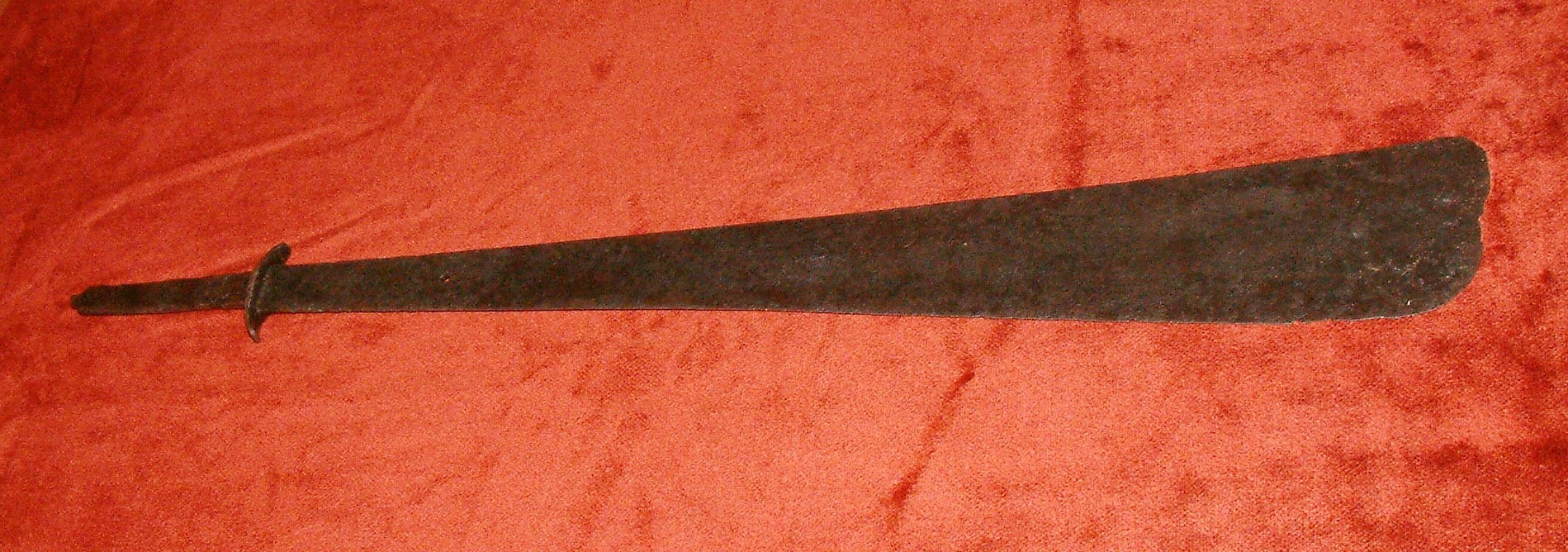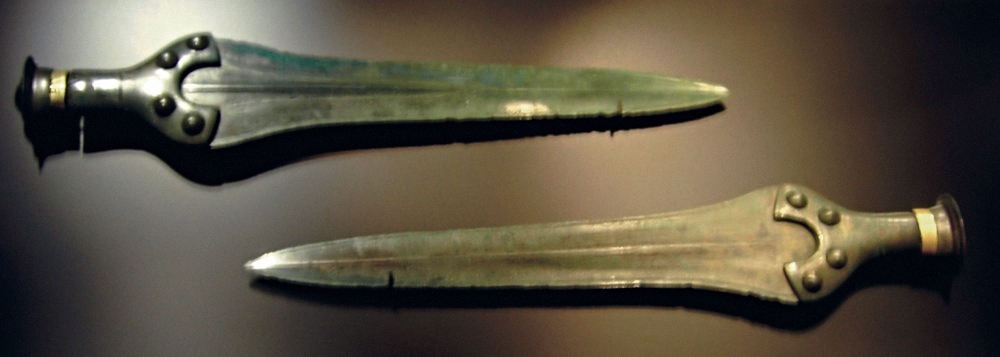Swords are some of the coolest weapons both in history and in TV and movies. The weapon has a long history, spanning several millennia and still fascinates people today. The swords on this list are not only some of the oldest swords ever found, but they are also some of the most notable. A few of the swords are part of various European royal ceremonies and have legendary histories.
10. Sword of Saint Galgano
Age or Year Created: c.12th century
Location: Montesiepi, Tuscany, Italy
Made Out Of: Iron
Used By: Saint Galgano Giudotti

The sword was placed in the stone by Saint Galgano, who had visions of the Archangel Michael while traveling to Montesiepi. Galgano was asked to give up his material possessions and to prove that that would be as easy as splitting a rock, he plunged his sword into a stone and it has remained there since then.
Did You Know?
Only the hilt, grip, and about 3ft of the blade of the Sword of Saint Galgano are visible and all the pieces have been dated to the 12th century and come from the same artifact, which means it has never been tampered with.
9. Curtana
Age or Year Created: c.11th century CE; current sword from 17th century CE
Location: United Kingdom
Made Out Of: Steel
Used By: Edward the Confessor; now only ceremonial

Curtana is part of the Crown Jewels of the United Kingdom and one of the five swords used for the coronation of British kings and queens. The original Curtana dated to the 11th century CE and was supposedly used by Edward the Confessor, who reigned from 1042–1066. However, the current Curtana is a replica created in the 17th century for Charles I’s coronation in 1626.
Did You Know?
Curtana is also linked to Tristan, the hero of the Arthurian legend Tristan and Iseult. According to legend, Ogier the Dane, one of Charlemagne’s (King of the Franks) paladins, inherited Tristan’s broken sword (Curtana has a square tip) and called it “Cortain.”
8. Joyeuse
Age or Year Created: c.10th to 13th century CE
Location: Paris, France
Made Out Of: Iron
Used By: Charlemagne

La Joyeuse, which translates to “joyous”, is the only sword that has ever been used as the coronotion sword of the Kings of France. Although no one knows for sure, La Joyeuse supposedly belonged to Charlemagne (Charles the Great), King of the Franks in the 8th century.
The earliest known record of the Joyeuse sword housed in the Louvre dates to only 1271 CE when it was used during the coronation of Philippe III the Bold.
Today, La Joyeuse is a composite of several different pieces dating from various periods of France’s history.
Did You Know?
La Joyeuse was last used to crown a French king in 1824 at the coronation of Charles X.
7. Sword of Saints Cosmas and Damian
Age or Year Created: c. late 10th or early 11th century CE
Location: Essen, Germany
Made Out Of: Iron and gold filigree
Used By: Unknown; sword became ceremonial around the 10th century

The Sword of Sains Cosmas and Damian or the Sword of Essen dates to sometime around the late 10th century CE. It is believed that the sword was actually used in combat before it was later decorated to commemorate the martyrdom of Saints Cosmas and Damian, the patron saints of Essen, Germany.
Reportedly, the Sword of Essen was a gift from Otto III, Holy Roman Emperor to Essen Abbey, which is where the sword still resides.
Did You Know?
Silver locket mounts showing images of Saints Cosmas and Damian were added to the Sword of Essen in the 15th century, along with an inscription that reads GLADIVS CVM QVO DECOLLATI FVERVNT NOSTRI PATRONI (“the sword, with which our patrons were beheaded”).
6. Sword of Saint Peter
Age or Year Created: c.10th century CE (possibly as early as the 1st century)
Location: Poznań, Poland
Made Out Of: Iron
Used By: St. Peter

The 10th century CE sword at the Poznań Archdiocesan Museum in Poland is claimed to be the sword of Saint Peter cut off the right ear of the high priest’s servant at the time of Jesus’ arrest in Gethsemane. However, as is the case with any holy relic, there is some controversy over authenticity.
The sword in Poland only dates to the 10th century, long after the time that Saint Peter lived. This is because the sword is most likely a replica, but newer research suggests that sword could have been made as early as the 1st century CE.
Regardless of what you believe, the sword of Saint Peter is treated like a holy relic and revered by its visitors.
Did You Know?
Although the Sword of Saint Peter may not have actually been used by the saint, it is the oldest documented sword in Poland.
5. Kogarasu Maru
Age or Year Created: c.8th century CE
Location: Japan
Made Out Of: Steel
Used By: Unknown

The Kogarasu Maru is a unique Japanese sword that bridges the gap between the earliest Japanese swords (which were double-edged and based on the Chinese jian) and the traditional tachi used by samurai, which evolved into the katana. This makes the Kogarasu Maru the oldest samurai sword in the world.
Although the Kogarasu Maru has an incomplete signature it is strongly believed that the sword was created by legendary Japanese swordsmith Amakuni, who created the first curved Japanese sword — the Kogarasu Maru has a curved double-edged blade.
Did You Know?
Not much is known about the Kogarasu Maru publicly besides its connection to the Taira family and that the sword’s name means “Little Crow” in Japanese. There are various legends about how the sword got its name.
4. Seven-Branched Sword
Age or Year Created: c.369 CE
Location: Isonokami Shrine, Nara Prefecture, Japan (sword was made in Korea)
Made Out Of: Iron
Used By: N/A, sword was ceremonial

The Seven-Branched Sword or shichishitou in Japanese and chiljido in Korean originated in Korea sometime around the 4th century CE. The sword was a gift from the king of Baekje (a kingdom in southwestern Korea) to a ruler from Japan’s Yamato period. There is an inscription inlaid with gold on the central blade of the Seven-Branched Sword that describes the relationship between Japan and Korea.
Did You Know?
The real Seven-Branched Sword is kept safe at Isonokami Shrine in Nara Prefecture and is not on public display. Only replicas of the sword are in museums in Japan and Korea.
3. Sword of Goujian
Age or Year Created: c.771 to 403 BCE
Location: Hubei, China
Made Out Of: Bronze
Used By: Unknown

The chemical composition of the Goujian sword — copper, tin, lead, and trace amounts of sulfur and arsenic — is the reason why the sword has remained in pristine condition.
Did You Know?
In 1994, the sword of Goujian was damaged while on loan to Singapore for display. Since then, China no longer allows the sword to leave the country and it is currently owned by the Hubei Provincial Musuem.
2. Nebra Sky Disk Swords
Age or Year Created: c.1600 BCE
Location: Nebra, Saxony-Anhalt, Germany
Made Out Of: Bronze and copper
Used By: Unknown

The Nebra Sky Disk hoard is one of the greatest archaeological finds of the 20th century, a claim backed by the UNESCO Memory of World Register. Although the centerpiece of the sword is the Sky Disk — a beautiful bronze disk inlaid with gold celestial symbols — two bronze swords as well as two hatchets, a chisel, and spiral bracelet fragments were also discovered.
The bronze swords and the entire hoard were buried around 1600 BCE, but scientists have been unable to date the time of manufacture, meaning the artifacts are probably much older.
Did You Know?
The Nebra Sky Disk swords feature copper inlay and are one of the rare examples of a true inlay technique from this time period outside of the Mediterranean.
1. Swords of Arslantepe
Age or Year Created: c.3300 BCE
Location: Arslantepe archaeological site near Malatya, Turkey
Made Out Of: Arsenic-copper alloy
Used By: Unknown

The Arslantepe swords are made from an arsenic-copper alloy and were found in relatively good shape. These weapons have a total length of 45 to 60 centimeters (17.7 to 23.6 inches).
Did You Know?
Three of the nine swords of Arslantepe are inlaid with silver and have beautiful designs on their hilts.
OTHER POSTS YOU MAY BE INTERESTED IN











